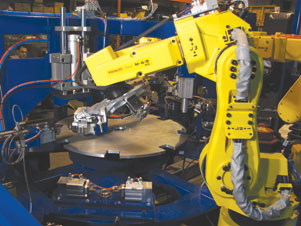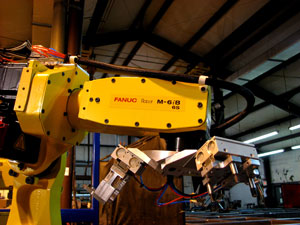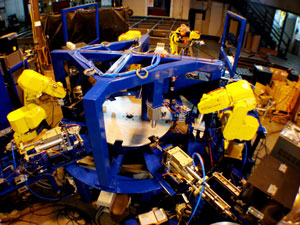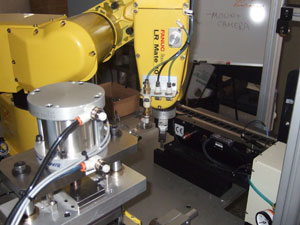January 2008 Edition
robotics
Articulated robots win points for flexibility and dexterity
 FANUC six-axis robot with multi-tool end effector provides flexibility for two unique parts and two separate assembly operations without station changeover.
FANUC six-axis robot with multi-tool end effector provides flexibility for two unique parts and two separate assembly operations without station changeover.
The need for automation and robotics grows stronger every day as labor costs rise and competition from low-wage overseas locations intensifies. At the same time, today's product lifecycles are becoming shorter and the demand for customization and subsequent part complexity grows greater. Many products (not to mention their components) are becoming smaller and tolerances tighter. Flexible, controlled automation often is the only way to guarantee production efficiency and high quality.
As a result of the advancements of automation in general and robotics in particular, the assembly process is faster, more efficient, and more precise than ever before. Fortunately, as each new generation of robot technology is introduced, speed and performance improve and costs decrease. Automation and robotics, therefore, become more affordable and valuable to the manufacturer.
Conventional wisdom of the past steered some assemblers to the Cartesian coordinate robot, which consists of an orthogonal-axis structure.
"Two- and three-axis non-servo Cartesian devices have a lot of components like cylinders, solenoids, tubing, and switches," explains James C. Cooper, distribution network account manager for FANUC Robotics America Inc. "This complexity leads to several points of potential failure, but that can all be replaced by one of our robots, at a significantly higher mean time between failure, which is now 78,000 hours for our robots."
The current most popular robotics solution for assembly is the four-axis SCARA robot arm, which can move to any X-Y-Z coordinate within its work envelope. There is a fourth axis of motion, which is the wrist rotation. The X, Y, and roll movements are obtained with three parallel-axis rotary joints. The vertical Z motion is usually an independent linear axis at the wrist or in the base. SCARA robots are typically used in 2-D assembly operations where the final move to insert the part is a single vertical motion. Component insertion into printed circuit boards is an example. SCARAs are very common in pick-and-place, assembly, and packaging applications.
"You could do a specific pick and place with a pneumatic mechanism, but if you get into an application where you needed to possibly shift the part or rotate the part, then you're adding two or more mechanisms together," says Mike English, president of the Warwick, RI-based integrator Interplex Automation. "With how robot prices have come down so much over the years, I could design and build a pick-and-place unit and by the time I put all the slides together and make or buy adaptor plates, put sensors on the mechanism, assemble it, wire it, plumb it, and add up my raw material cost and my labor cost, it's about the same as what a robot's going to cost. With a robot, you just bolt it to a table, program it, and it's ready to go."
The advantages of a vertically articulated robot compared to a SCARA are its flexibility and dexterity.
"Sometimes workpieces come into the robot cell at an angle and with SCARAs, something has to be done to make the part flat. That's additional cost and additional hardware," Cooper explains. "With the dexterity of the vertically articulated robot, you can use the robot to pick up and re-orient the part."
 FANUC six-axis robots allow for parts to be manipulated gently and accurately.
FANUC six-axis robots allow for parts to be manipulated gently and accurately.
Five- and six-axis articulating robots also are more adaptable to variations or changes during a project, and offer more flexibility during and after a program.
"The robot is programmable where the pick-and-place unit isn't," English says. "There are always changes in design and process."
English describes a robot he first installed for assembly, after which it was asked to help perform an in-process inspection. "The robot allows me to stop along the way, vision-inspect the part, and place it either in the reject bin or where it needs to go next in the process," he says. "That's an easy change. I don't need to build a whole lot of other stuff. The robot is the material management unit."
Mark Senti, vice president of Advanced Magnet Lab Inc., an integrator based in Melbourne, FL, cites an example where an odd-shaped circuit board is inserted into a tight-fitting key fob. Both components were on the far edge of the specification and to insert the circuit board, a six-axis FANUC robot was programmed to first tilt and then roll it into place.
"A four-axis solution would make it almost impossible to insert that vertically," Senti says. "A six-axis robot allows you to manipulate the part very gently and very accurately. With hard automation, you're stuck if a change is made after installation. Robotics allows you to easily and quickly adapt to these changes."
Despite the advancements in robotics, integrators still specify Cartesian and SCARA systems because of their history of and reputation for high-speed, high-precision, standard control platforms, and – until recently – lower cost compared to five- or six-axis articulating robots.
Cost structure
In the past, the greater flexibility and dexterity of articulating robots has been offset by slightly slower speeds and higher costs. Because of that, and their years of experience with Cartesians and SCARAs, many integrators and manufacturers are more comfortable with these standard forms of automation.
As articulating robotics technology advances, however, many of the advantages associated with Cartesian and SCARA are dwindling. Vertically articulated robots are becoming faster, their control platforms smaller, and as the technology matures, becoming less expensive.
Vertical articulating robots generally increase quality, reliability, and performance while greatly reducing risk. Engineering costs are a fraction of traditional systems as a robot is a significant part of an assembly system that is fully designed and proven, with fewer electrical and mechanical components. Along with engineering, the cost to assemble, setup, test, tear down, and install are much greater when using traditional pick-and-place devices.
 Four FANUC six-axis robots assemble of two different products simultaneously, increasing system flexibility, reliability, and capability.
Four FANUC six-axis robots assemble of two different products simultaneously, increasing system flexibility, reliability, and capability.
Robots also are easier to integrate, requiring less time to debug and fine tune. They are easier to maintain; just grease the joints every six months and change the battery once a year. They are more reliable than traditional systems and typically eliminate the total number of components in a system by performing multiple tasks.
Senti is a big believer in robots and says he studies four key factors when selecting a supplier. The company must have a large selection of robots, a common platform, have application software available to ease integration, and offer integrated sensors and vision systems.
"When selecting a particular robot for a project, my first choice is always a six-axis robot, which provides greater flexibility, capability and inherently reduces the risk in the project," Senti explains. "For small parts assembly, there's the perception that SCARA and Cartesian robots are better suited for the application. Today's articulated robots are equal to the task in terms of speed, precision, and cost."
The LR Mate 200iC from FANUC Robotics is a prime example of what Senti is referring to, and it meets his criteria. It is a servo-driven mini-robot offering best-in-class performance in a light, efficient, accurate, and nimble package. Its tabletop size, slimmer arm profile, lighter weight, high dexterity, faster sustained speed and superior positioning accuracies make it a viable alternative for countless industrial and commercial applications, including assembly. It also continues a trend toward offering more features for less cost than the model it replaces.
Numerous benefits
"In the last six or seven years, there have been so many advancements in robot technology," says Mark Handelsman, manager of Industry Marketing at FANUC Robotics. "Motors are smaller and more powerful. Processor speed has increased since the last LR Mate was introduced. There's a lot we can do today that we couldn't do a few years ago."
Handelsman adds that repeatability has increased two-fold and speed increased 50 percent between the old and the new LR Mate.
With the increase and speed and the lower cost, LR Mate 200iC gives more manufacturers and assemblers an opportunity to take advantage of the benefits of articulating robots while sacrificing nothing.
"We made a very focused effort to put this product in the lower cost-more value part of the assembly market," says FANUC Robotic's Cooper.
FANUC Robotics says its new LR Mate 200iC will make previous users of Cartesian and SCARA automation think seriously about moving to five- and six-axis articulated robots.
"The mindset is that only SCARAs can deliver precision and speed," FANUC's Handelsman says. "Now our LR Mate 200iC robots have it, plus a lot of things that our competitors don't have."
One is the R-30iA Mate controller, which uses advanced technology packaged in a proven, reliable and efficient controller design. FANUC Robotics' plug-in design provides flexibility for application specific configurations and a common look and feel for a wide range of users of the system. This integrated peripheral machine control (PMC) provides ladder-logic control for many peripheral devices.
Vision and force
The iRVision integrated robot vision system is ready-to-use and requires no additional hardware except for a camera or sensor and cable. It provides 2-D or 3-D robot guidance and/or an error-free proofing tool to accomplish part location, presence detection and other operations that normally require special sensors or custom fixturing.
 FANUC's new LR Mate 200iC, equipped with collision detection and singularity avoidance software, assembles a plastic component.
FANUC's new LR Mate 200iC, equipped with collision detection and singularity avoidance software, assembles a plastic component.
Integrated force sensors provide 3-D assembly using standard sensor setup schedules and processes specific force control instructions that make the intelligent robots easy to program and operate via the FANUC iPendant.
Intelligent robots with force sensors offer assembly and process solutions for clutch insertion; valve, bearing and shaft insertion; spline matching; gear assembly; flexible part feeding; material removal applications, welding; and product lifecycle tests such as door and switching operation and other applications requiring constant force.
They provide force and motion control, for example, to insert a clutch unit into an automatic transmission unit of an automobile. The clutch insertion force schedule includes direction, contact force, approach velocity, push force, rotation limits, search frequency and search amplitude to perform the operation. Once the force schedule is set, a simple force control instruction is added to the robot program to perform the insert operation the exact same way every time. Other functions include variable spline matching, contouring, a uniform pushing force, and built-in diagnostics if sensor data is out of range.
In addition to the integrated vision, controller and force sensors, the LR Mate 200iC features six degrees of freedom, 0.02 mm (0.00079 inches) repeatability at full payload and full speed within the entire robot work envelope. It has up to 5 kg (11 pounds) payload at the wrist along with best-in-class wrist movements and inertias for real-world workpieces.
Lighter and more compact than its predecessor, the LR Mate also has a slimmer arm to allow operation in narrow spaces, giving it its ample work envelope, between 246 and 704 mm (9.6 to 27.7 inches) from the center of the robot. Its tabletop size, slim wrist and small footprint permit operation in tight work spaces, yet it can flip over backward for a larger work envelope.
Performance leap
The new robot's high joint speeds maximize throughput and its high-precision Z motion was once thought possible only with a SCARA. It is 50 percent faster than the previous LR Mate and is able to do eight standard 1-12-1 inch test cycles in 7.1 seconds. Its high rigidity and the most advanced servo technology enable smooth motion without vibration in high-speed operation.
"We had a very significant leap in performance with this most recent series, that's what's opening the market," Cooper says. "Almost a 50 percent improvement in speed. That's huge."
The LR Mate 200iC's reliability stems from its being the latest generation of a proven design. It has sealed bearings and brushless AC motors, an enclosed mechanical design that eliminates cables and hose snagging and has grease fittings on all lubrication points for quick and easy preventive maintenance. Further enhancing its reliability is its collision detection and singularity avoidance software. Singularity is the phenomenon that occurs when an articulating robot's joints line up.
Installation is extremely flexible with upright, angle, wall or inverted mounting. It has advanced communication capabilities via standard Ethernet and serial connections.
Another reason to make the switch to articulating robots is their reusability. For example, the LR Mate can be reprogrammed to do new tasks and still perform the original task. The robot can jump to the right part program based on an input device. Hard automation can do one task, either the original or the new, not both.
"Flexibility is big for the customer," English explains. "A product line might last three or four years. Then they want to retool things. They could take that robot and use it somewhere else or for a new task – that's a key advantage over hard automation.
"If a customer has the foresight to see that they have other potential programs in the future, they really need to take the flexibility and re-use aspect of robots into consideration," he says. Fanuc Robotics America Inc.,
www.rsleads.com/801tp-151
What do you think?
Will the information in this article increase efficiency or
save time, money, or effort? Let us know by e-mail from our
website at www.ToolingandProduction.com or e-mail the editor at
dseeds@nelsonpub.com.